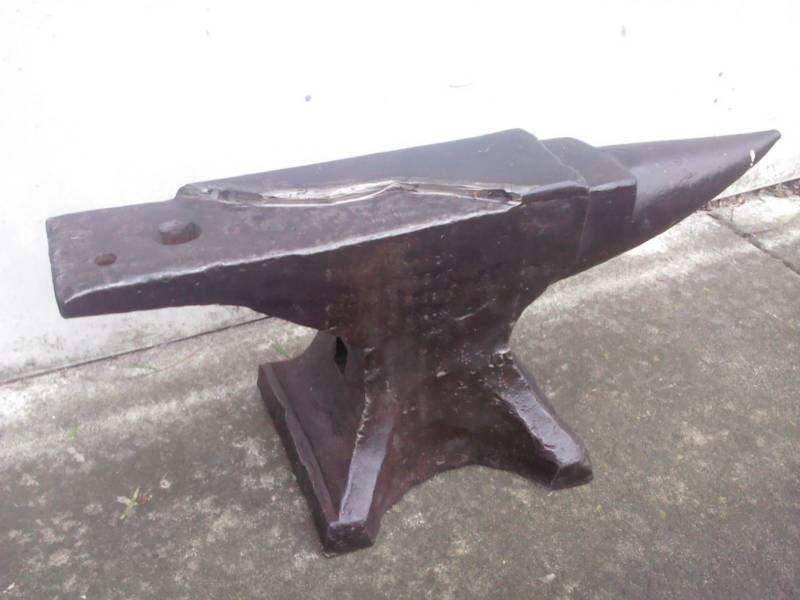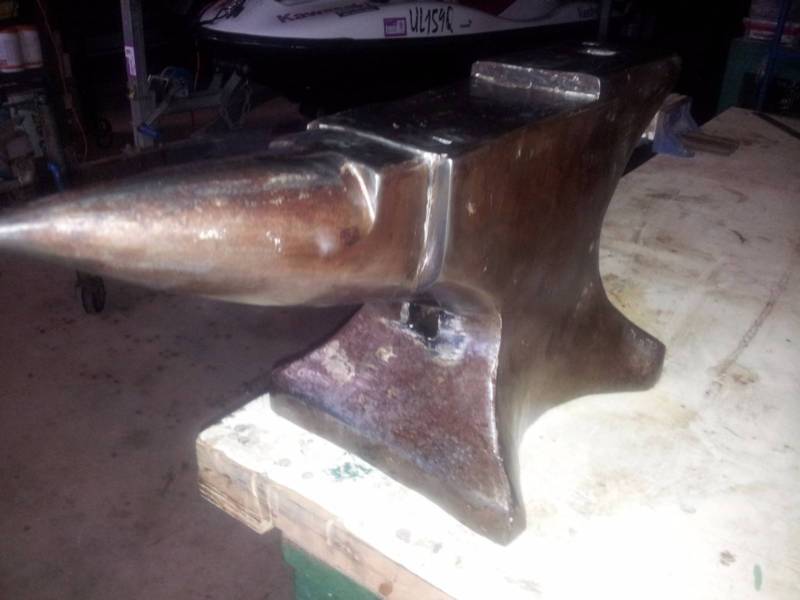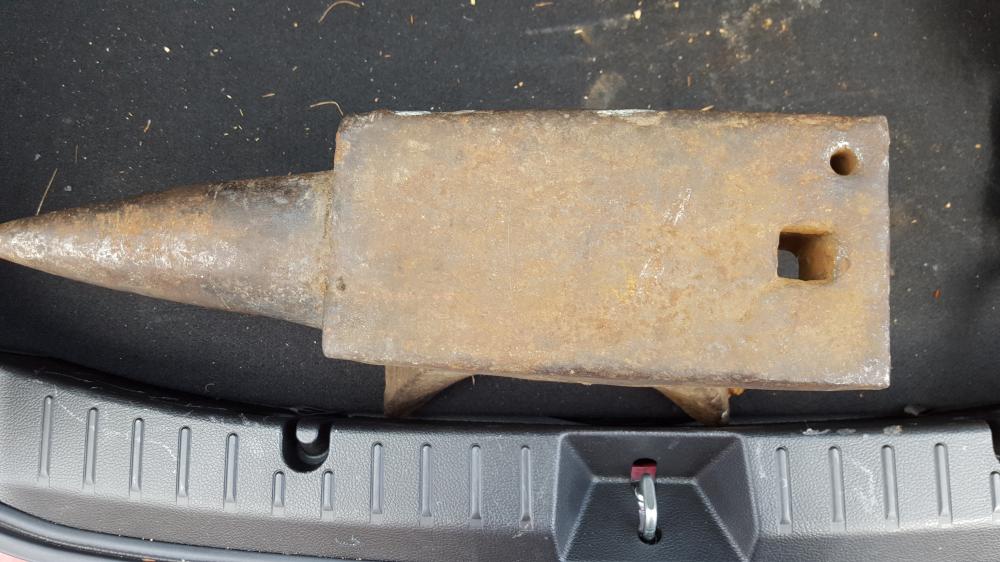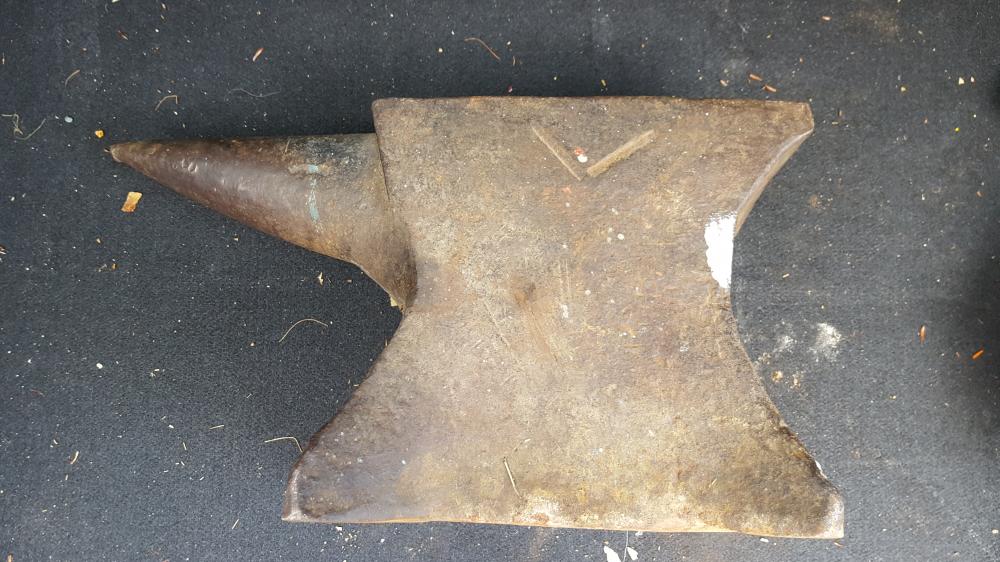
falsevacuum
-
Posts
74 -
Joined
-
Last visited
Content Type
Profiles
Forums
Articles
Gallery
Downloads
Events
Posts posted by falsevacuum
-
-
From my perception of prices in the states, $800 is a bit pricy relative to market price.
But if it's a Hay Budden in mint condition, it may well be worth it to you. On the other hand, if it's got a huge crack, it probably isn't worth more than $100.
But, as previously mentioned, if you can afford it and to you it's worth it, go for it.
-
The usual question asked is "where do you live?" Since prices vary greatly depending on where you live.
-
28 minutes ago, Charles R. Stevens said:
Nope, Falsevaccume. The bottom flange of the rail provides a nice taper and TJ fully welded it with 7xx wire. I think the feet are peremiter welded but the face and horn are full penitration welds.
Oh, wow. That's pretty impressive! That must have been a heck of a lot of welding. Thanks!
-
1 hour ago, T.J.watts said:
Thanks guys, the top plate is the bottom flange from heavy gauge rail. The body is 50k and the horn is 1018. It's actually seven pieces with lots and lots of welding.
It looks like you welded the outside of the top plate. So there would be a gap between the plate and the body. Is that right? Are you worried about that?
-
That's awesome!
Is the entire thing tool steel or did you weld a face on?
Edit: derp didn't see build page link
-
1 hour ago, stan said:
That feels almost criminal.
I take it this is what face delamination is?
Ha, I'd almost be tempted to seem super interest, then show up and test the rebound and offer scrap price.
-
An ASO will have almost no rebound. I can full force smack my ASO and I get no kick back, it just leaves a dent instead.
If it's got very little rebound, it MIGHT have been through a house fire, but that's doubtful. Someone other than me would know better.
If you can dribble your hammer on the anvil, I think it's probably fine. (If you hold the hammer loosely and let it drop from maybe 2", does it bounce a couple of times?)
-
I'm a beginner, so go find your salt shaker and get a few grains. I do read a lot, but reading is no substitute for experience.
> TPAAAT
Since it's not sure easy to find exact details of it, the two minute version is ask everyone you know to ask around. Talk to the cab driver, the wait staff, go to the flea market and talk to the tool or antique dealers there and let them know what you're looking for. Get the word out: AuburnMind is looking for an anvil. Most people who work at it succeed within a week to a month, from what I've read.
Hammer you can get from a hardware store for a bit of money, if you don't want to search too hard. I bought a 2lb cross peen from Amazon for $20, then ground it to an acceptable face. The forged one I bought used at a conference is much better, but buying blacksmithing equipment can be difficult and often expensive outside of a blacksmith group. Depends on if the convenience is worth it to you.
A forge can be built, but many beginner forges have flaws. So base your design off a commercial forge is the advice I've been given. As mentioned above, a forge can be a hole in the ground with air blown into it. But if you can get a raised one, I'm sure your back will thank you later.
There are lots of examples of makeshift anvils that work quite well. Railroad anvils (set tall, not wide), forklift tine anvils, etc. Google is your friend here. If you drop by your local scrapyard, they may have what you're looking for. TPAAAT is an option for a more "traditional" anvil.
In the states, we have ABANA affiliates: local blacksmithing groups. I assume there's something similar in the UK? If so, that's a good bet.
-
I've read the ductile iron anvils make fine anvils. They do a special heat treatment that brings them up to good anvil hardness.
I wouldn't suggest discounting them without looking into it more. I recall reading some reviews of them from very satisfied smiths.
-
I'd be hesitant to use that ol' gal as a striking anvil. The top is in rather pristine condition and it wouldn't take but one slip with a sledge to take a sizable chunk off of it.
I won't be using more than an 8lb sledge, and probably not too agressively either (swinging from the side, not over the head). If I end up going heavier, I'd go find myself a steel block to use. Hopefully nothing bad happens!
Lovely pre 1820's anvil---good conformation for a heavy work anvil---thick waist; little overhang. It's yours and you can use it as you like.
Thanks for the info! That's pretty exciting and I'll do my best to take care of and put to work this piece of history. Yes, that was one of my first reactions seeing that: little need to worry about taking off the heel! I think I should still be careful around the horn though.
-
"V" looks like it was added later; does look old. Does the pritchel look drilled rather than punched? I'm thinking it might be a retrofit and that's a pre-1820's anvil
The pritchel hole is SO much cleaner than the hardy hole. The hardy hole is an uneven mess inside, the pritchel hole is quite straight and clean. So my guess is: yeah, it was drilled.
-
-
I've only been forging for a short while, so I don't have the experience a lot of folks do, but I forge in a t shirt with pants and boots. If I use tennis shoes, I can scale burns in them, and I bet dropping steel would be bad.
I find gloves are only necessary for twisting (scale falls on your hands)
I find a jacket is nice if you're welding but otherwise unnecessary.
I used hearing protection before I put about 6 hard disk magnets on it. Now I don't use hearing protection.
Something to protect your eyes is thr only thing I can definitively say is a must.
-
I've nothing useful to add. I apologize for my comment.
Frosty The Lucky.
Thanks. I agree I overstepped my bounds, my mistake. Apologies for that as well.
I think you do have something useful to add: better information.
-
To be honest, the quieting part is mostly for the neighbors, who haven't said anything yet. I don't terribly mind the bell sounds... Makes me feel like I'm being accompanied by a choir of really loud bell ringers.
Welive in the middle of town. Most of the neighbors are old folks. One house next to us is vacant.
I can't get at
-
Again, I'm no expert, but my understanding is they're pretty good anvils.
The best anvils would be Hay Budden and Peter Wright and maybe Fisher? Mouse Hole is kind of the class right below that. Good but not the best.
These anvils have a wrought iron base with a forge welded steel plate.
In the end, an anvil is an anvil. Doesn't really matter too much. When you start getting to professional quality anvils, a beginner like you or I probably won't notice the difference between the different brands.
-
How'd I do? Now should I oil it down or what?
Nice find, great price!
I'm just a newbie, but my Mousehole (I believe that's what you've got there. They say M&H Armitage Mouse Hole on the side) sits outside. I cover it with a tarp when I'm done. The rust goes away quickly with a little hammer work.
If you really love the shine, I've heard you can leave an oily rag on the face, but it's nothing more than cosmetic.
-
I know hand problems. You say you have not done a lot of physical work. What do you do for a living, and how much time do you spend on the computer?
I'm a CS undergrad student, was doing CS research full time has been my longest job.
So a lot of computer time.
One variable no one has mentioned is the heat of the stock. dull red is a lot harder than a bright heat and would cause more shock. As a new smith I spent way too much time beating on cool metal.
Could be part of it. Maybe I was pushing the colors too far.
For sledge work I was taught to cross over with my hands on the handle. For a right hander like me the right hand goes towards the top of the handle, and the left hand goes across my body and grips the bottom of the handle. This gives you very accurate blows, as you swing the hammer up and down. You become more of a helve hammer than a swing over the head striker.
I think this is what I was doing. Dominant hand near the head, off hand about 2' down. Both hands on the dominant side. Is that right?
A fresh from the box store hammer has to atleast have the sharp edges and swirls dressed out, but placing a peice of ply on the anvil and give it a wack or three. This will tell you if the anvil is the right hight for sledge work but fast.
I took a second look. Sharp edges indeed. I dressed them to a radius.
I'm thinking it was probably just weak muscles. Over the summer I was forging every week twice a week. Once classes started up I couldn't forge for 4 weeks or so and I bet I lost a bunch of muscle. I found my 2lb cross pein gave similar problems 2 weeks later, and it never used to do that. That also points in the direction of weak muscles.
Also, side note, what length should I cut the handle down to? I feel like 3' gets in the way. I was thinking 2'.
-
The first time I ever witnessed blacksmithing was on a lower/middle school field trip. The smith made a nail and showed everyone. I didn't think much of it.
Fast forward 10 years, fall of 2014, I was 20 years old and stumble across a YouTube video of some guy forging a knife or something. I watched all of his smithing videos and thought it was pretty cool, but it seemed like everyone says you need to weld your forge together. (I now know that's not true) I didn't have a welder, so I tabled the idea as a fantasy. Over time I thought about it occasionally and thought it would be pretty cool to do.
Then February 2015, and I was taking a class on theater tech to satisfy my art credit. I asked if they'd teach me to weld. They said yes, but never did. I kept bugging them about it, and eventually told me to come up with a project. Thought about for a bit and said "hey, what the heck, let's build a forge". I spent maybe 20+ hours researching forge design, creating drawings, and searching for parts. Soon enough I had myself a little charcoal forge!
Now I'm mostly trying to learn technique. I want to make myself a pair of v-bit bolt tongs, but I'm a bit of a perfectionist and keep saying "not good enough. Scrap pile!" Tool making is what really interests me. I dream of making my own hammer one day. Also I plan to make some adult toys for friends but that's another story

During the day I go to a small college in NH, studying CS. Currently trying to finish up my undergraduate thesis. I also work at a machine shop part time, but I was doing research full time for 6 months before this term.
-
Judson:
Thanks! This is one of the awesome things about small groups. Good to know I'm in the ballpark for size. The hammer has a 3' hickory handle. I think we were using the shorter handles -- were those 2'? It was a great meet, and thanks for letting us use your equipment!
ThorsHammer82/Charles R. Stevens:
I don't think the face needs dressing. It's actually pretty round as is.SpankySmith:
Yeah, that could be an issue. Maybe I'm gripping too tight.The other thing I was thinking might be an issue is if I'm holding to close. I haven't been able to try again since I posted this, but I recall I was holding up pretty close to the head (a few inches a away). Could that be a part of the issue?
-
How did you dress the handle before using it? If you have to hold the handle real tight you will transmit more of the shock into your hand and arm than if you can use a loose grip. Issues may include---wearing gloves, handle too thick, handle coating not hand friendly, handle shape means you have to grip tighter, etc.
I didn't dress the handle at all. No gloves. The handle coating didn't feel too weird.
what handle materials? both the one you used at the conference and the one you bought.
were they both store bought, or were they dressed?
What were the differences in the Anvils? stands? Maybe a different metal being hit?
I don't have an answer to your question, but I think that this information can help people determine what may have been the issue.
Both were wood. I suspect at the conference, the one I used was dressed, but it wasn't mine. I don't remember the shape of the handle, unfortunately. I didn't dress mine, just the one that was attached.
The anvil I was using at the conference was a little below knuckle height, and about 100lbs. At home, about halfway between knuckle and wrist, and about 150lbs. Stands were both metal stands. Mild steel in both cases.
How old are you? Nearest decade will do…and have you done much physical work before? My hand has gone in to a claw more often since passing 55...
What size of stock were you hitting each time?
How heavy was the hammer you used at the conference…8lbs sounds a bit light to me.
Alan
I'm in my early 20s. I haven't done a whole lot of physical work, aside from forging with a hand hammer and yard work/piling wood.
Stock was about 1/2 stock both times.
I think the hammer at the conference was pretty close to the 8lb one I bought, but that's just a guess...
-
Hi all,
At the New England Blacksmiths conference last week, some awesome people showed me how to use a seldgehammer. I had no problems using it and had a lot of fun! I didn't remember the weight though. I went and picked up an 8lb sledgehammer from IFI's favorite hardware store, Home Depot, and gave it a try. To my surprise, it seemed to have a heck of a lot more shock than the sledgehammer I used at the NEB meet. Moreover, after a round or two of striking, my fingers were so sore that I had trouble opening them. The feeling mostly passed within a few minutes. The other person I was working with experienced similar difficulties. When I woke up the next morning, my fingers were a bit sore.
This hasn't happened to me with a hand hammer before.
Any idea what the cause (and fix) to this problem might be?
My two thoughts are:
1) Maybe I'm choking up too tight and too far up on the handle?
2) Maybe the hammer head is attached too tight?
Thanks!
-
Vapors go around corners just fine. When Thomas says not in the same space he means the same ROOM Period. Remember, physics doesn't care how we parse words it just IS.
Find an old Gym locker at a yard sale and bolt it to the outside wall of the garage and you're golden.
Being attached doesn't require open floor space or a door, the roof is attached so you have open space through the rafters/trusses right where all the HOT is going to go.
Frosty The Lucky.
Ah, I thought he was talking about flying chunks hitting flammable containers. Yeah, we don't have much flammable volatile stuff, just a 1 gallon thing of acetone and a 1 gallon thing of paint thinner. If I can find a locker, I'll put it in one.
-
This is my strong opinion: things like acetone, gasoline, anything with flammable vapors should not be in the same space! I am willing to allow exceptions for workspaces not associated with living spaces; but even a small risk takes on different look when associated with one's home.
I have been very lucky the last 34 years to be forging in structures not attached to my house! (you already know not to have a car nearby in case something travels---grinding with an angle grinder is notorious for messing up windshields and paint jobs...)
Hmmm... good point. The garage shares a wall (but not a door) with the house, so I think I should keep them, at the very least, around the corner with no line of sight to them. Also, I'll have to make sure all the cars are out the garage!
You can get soft wool base layers; "Smartwool" is one brand.
I thought Smartwool was synthetic, but on further research, it's not! I've got some Smartwool long underwear I can wear.




M&H Armitage Mouse Hole Anvil
in Anvils, Swage Blocks, and Mandrels
Posted
The coloring on the edge looks a little off. Is it possible this anvil was welded up? Or am I mis-seeing things?